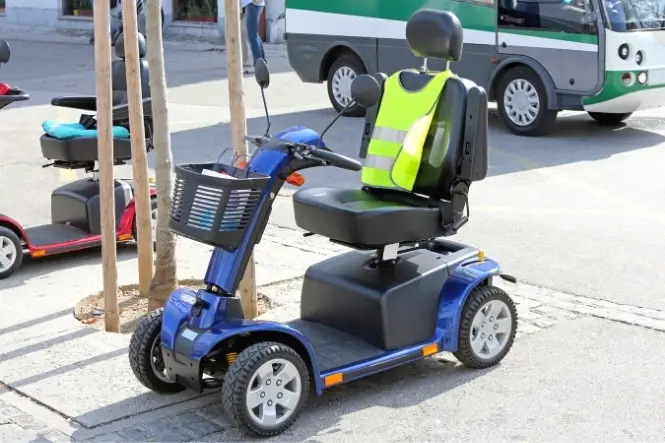Quality mobility scooters have the potential to transform the lives of the elderly and the disabled, dramatically improving their overall quality of life.
But while these scooters have fantastic reputations for rock solid reliability, like everything else man-made they will eventually need preventative maintenance, regular upkeep, and (sometimes) emergency repair.
Below we run through seven of the most common mobility scooter problems and how to fix them yourself (or find someone to fix them for you without spending a small fortune).
Let’s jump right in!
Battery Issues
If there is one universal “issue” that most mobility scooters will be played with at some point it has to be battery problems.
Charging, discharging, and recharging scooter batteries inevitably puts a lot of wear and tear on even the best battery technology.
Most modern scooters will let you know that your battery needs to be swapped out for a new one as its lifecycle depletes, but every now and again you might have battery issues where they just sort of “go on the fritz”.
Double check all connections, check the voltage of your battery with a multimeter, and make sure that there’s no corrosion or other obvious signs of wear and tear on your battery. If everything else checks out it’s probably time to make a swap.
- 🍶WIDE APPLICATION: The universal fit cup holder can be attached on anything with a 1.5’’ to...
- 🍶REINFORCEMENT STITCHING: The adjustable velcro straps are reinforced to hold the cup holder...
- 🍶MULTI-FUNCTION DESIGN: Not just a cup holder! It is also ideal to hold bottle, cell phone, wall...
Motor Flat Spots
The motors on mobility scooters are engineered to be unbelievably reliable, even more reliable than traditional scooters (most of the time).
If you have a scooter with some age on it, though, you might begin to experience motor problems called “flat spots”.
This is where a motor temporarily powers down, causing your scooter to decelerate and that accelerate out of nowhere – and with no real predictability. If you feel your scooter bumping along it’s probably a flat spot issue that needs to be addressed ASAP.
Unlike the other issues on this list, this isn’t something you want to tackle on your own. Find an expert that can do it for you!
- FITS ALL STANDARD WHEELCHAIRS: Durable wheelchair bag attaches with two easily adjustable straps,...
- HANDS FREE GRAB AND GO BAG: Easily keep essentials at hand with the large inner pocket measuring...
- EASY TO INSTALL ADJUSTABLE STRAPS: Easily attach and remove the carry bag with the durable...
Tire Problems
The overwhelming majority of mobility scooter tires are “hard” as opposed to “soft” and engineered to last for what feels like almost forever.
But as we highlighted above, eventually everything starts to wear and tear on a mobility scooter – and that goes double for the only thing on your scooter that is supposed to come in contact with the ground!
Be sure to check your tires on a regular basis, at least once a month.
You want to make sure that the sidewalls are good to go, that the tread is wearing evenly, and that there are no cracks or obvious signs of damage or rotting.
As soon as your tires start to wiggle or wobble, though, it’s time to have them balanced, repaired, or swapped out completely.
- Sturdy and Secure: The Bicycle Phone Mount has 4 stainless steel clamp arms with support corners to...
- Convenience Upgrade:The Bike Phone Holder has Super durable and Hyper elasticity Clockwork to...
- Rotation 360 Degrees: The phone holder and the handlebar connector are connected by a spherical...
Poor Throttle Control
The potentiometer, the throttle on mobility scooters, has the potential to go a little bit sideways every now and again as well.
Not only is this hardware responsible for the speed of your mobility scooter, but it also determines whether or not your scooter is going to go backwards or forwards, too.
Because this hardware is inevitably located on a spot on your mobility scooter that is exposed to a lot of elements (unless you drive exclusively indoors) the chances of it getting damaged or becoming corroded are significant.
If you feel comfortable working with electrical components you might be able to fix this all on your own. You want to make sure that you are careful rewiring the system, though. Swapping out old throttle systems for new throttle systems is generally pretty straightforward, too.
Ignition Issues
Just like the potentiometers we mentioned above ignition systems are exposed to the elements quite a bit, too.
This can cause your ignition key to get jammed up, your ignition to lockup or freeze, or can even cause your key to snap off and break if enough force is applied trying to turn your ignition on.
If you can’t remove your key (or the ignition just won’t release) you are probably going to need to swap it out for a new system. This is generally a pretty straightforward process, though again you’ll want to make sure you are comfortable working with electricity – and that you have removed your battery before jumping right in.
Steering Control Problems
After enough usage you may notice that your mobility scooter likes to sort of wonder around rather than travel in a straight line.
Misalignment problems can be caused by a variety of different factors (including badly worn tires as we mentioned above). But one of the biggest culprits is a misaligned steering system or steering column.
Depending on the complexity of your steering system this may be something that you can address just by holding the front wheels still and having someone else turn the steering column until everything is lined back up.
With more complex systems, though, you are probably going to have to bring your scooter to a shop or have someone else come out to handle the realignment process for you.
Electric Issues
Mobility scooters are (by and large) electric powered vehicles and that means that almost any component of the electrical system “on the fritz” can shut your scooter down or cause it to be unsafe for use.
Mobility scooters are especially prone to misbehave when exposed to moisture, including significantly humid environments indoors or out. It doesn’t take a lot of water in the system to wreak havoc.
On top of that, traveling on uneven and bumpy ground over extended amounts of time can cause wires and connections to jiggle loose. These are probably the simplest fix of all (you really only have to relock down the connections) but it still can become a bit of a headache when you feel like you are doing it all the time.
Closing Thoughts
At the end of the day, those are the seven most common problems you are most likely to bump up against when it comes to owning and operating a mobility scooter today.
Most of them can be fixed all on your own (for next to nothing), though some require a professionals touch to get the job done right.





